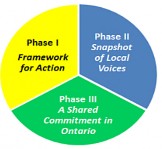Section 1 – Introduction
Setting the Stage
The ministry has been working with multi-sectoral government partners and local community and policing stakeholders to develop the Provincial Approach to Community Safety and Well-Being.
As ministry staff travelled across our diverse province throughout 2013 to 2016, we listened closely to local voices that spoke about the need to change the way we look at service delivery in all sectors. The common goal for Ontarians is to get the services they need, when they need them, in an effective and efficient way. Police are often called upon to respond to complex situations that are non-criminal in nature as they operate on a 24/7 basis. We also know that many of these situations, such as an individual experiencing a mental health crisis, would be more appropriately managed through a collaborative service delivery model that leverages the strengths of partners in the community. After engaging Ontario communities on our way forward, we have affirmed that all sectors have a role in developing and implementing local community safety and well-being plans. By working collaboratively at the local level to address priority risks and needs of the community through strategic and holistic planning, we will be better prepared to meet current and future expectations of Ontarians.
This type of planning requires less dependance on reactionary, incident-driven responses and re-focusing efforts and investments towards the long-term benefits of social development, prevention, and in the shortterm, mitigating acutely elevated risk. It necessitates local government leadership, meaningful multi-sectoral collaboration, and must include responses that are centred on the community, focused on outcomes and evidence-based (i.e., derived from or informed by the most current and valid empirical research or practice). It is important to note that although there is a need to rely less on reactionary, incident-driven responses, there continues to be a strong role for the police, including police services boards, in all parts of the planning process.
The ultimate goal of this type of community safety and well-being planning is to achieve sustainable communities where everyone is safe, has a sense of belonging, opportunities to participate, and where individuals and families are able to meet their needs for education, health care, food, housing, income, and social and cultural expression. The success of society is linked to the well-being of each and every individual.
Purpose
Community Safety and Well-Being Planning Framework: A Shared Commitment in Ontario is the third booklet in the series that outlines the Provincial Approach to Community Safety and Well-Being. It is a follow-up to community feedback highlighted in the Community Safety and Well-Being in Ontario: A Snapshot of Local Voices, released in 2014, and is grounded in research outlined in the first booklet, Crime Prevention in Ontario: A Framework for Action, released in 2012.
